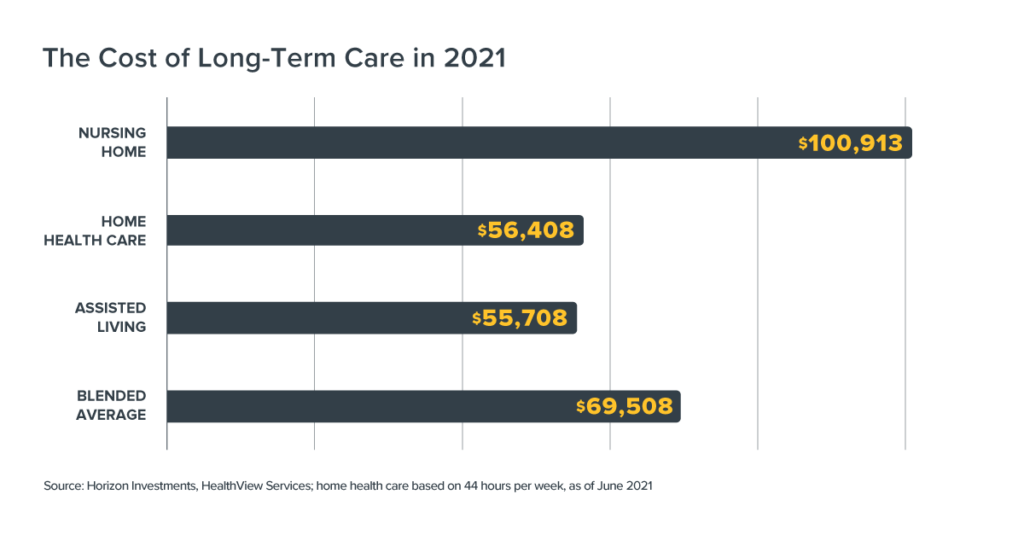About two-thirds of Millennials and Gen Xers would talk to a financial professional about how to use other income streams to delay filing for Social Security benefits until full retirement age.
The march higher in the cost of home health, assisted living or nursing home services continues. The blended cost of providing a year’s worth of long-term care is roughly equal to the price of a new Porsche Boxster sports car: $69,508.1
That’s a cost that either has to be covered by someone’s savings and assets, or an insurance policy. Government programs generally are of little help. Medicaid generally doesn’t cover the cost, while Medicare benefits are limited to retirees who have little, if any, assets. (related Big Number: Americans Seek Advice Amid Social Security’s Financial Stress)
(related Big Number: Americans Seek Advice Amid Social Security’s Financial Stress)
For goals-based advisors, the cost of long-term care services may provide another impetus to address longevity risks with their clients.
No matter how fit and healthy retirees work to be with the hope of avoiding major medical issues, on average they still face a good probability of hiring someone to take care of them for an extended period of time.
For example, a 65-year-old female, in good health, has a 56% chance of one day needing long-term care, according to HealthView Services. The probability for a healthy man is 44%.
However, before plugging a long-term care cost estimate into a financial plan, advisors may be well-served by asking clients: “how would you rate your own health?”
The Center for Retirement Research at Boston College found that there’s a “strong relationship’’ between the quality of a client’s self-reported health at age 65-70 and the care they eventually require.2
According to their research, 82% of people who said they were in “fair/poor’’ health subsequently had a moderate to severe need for long-term services and support. Among those who were in“excellent/very good’’ health, just 47% had a moderate to severe need.
(related Big Number: It’s Getting Harder to Fund Retirement Using Bonds)
It is a core belief at Horizon Investments that the most important risk people face in retirement is outliving their money. The rising cost of many things – with health care as a contributing source of retiree inflation – makes it critical, we believe, for goals-based investment managers such as ourselves to design ways to help advisors and their clients grow their assets during retirement with the aim of reducing longevity risk.
(Read Horizon’s Redefining Risk paper to understand our goals-based investing philosophy)
We believe Horizon Investments’ Real Spend retirement income strategy may be helpful as it was designed specifically with the aim of reducing longevity risk. It carries a greater exposure to equities, albeit with risk mitigation, than typically found in traditional financial advice with the aim of providing for necessary distributions, while also aiming to produce stable or growing assets over time.
(related Big Number: Over 65 Years Old and Working? That’s Not as Common Anymore)
See our Real Spend strategy and download our distribution stage brochure for further details about how advisors can help their clients tackle common retirement income challenges, including the cost of long-term care.
To download a copy of this commentary, click the button below.
Further reading:
Americans Seek Advice Amid Social Security’s Financial Stress
Over 65 Years Old and Working? That’s Not as Common Anymore
Are Glide Path Strategies Still a Good Option for Retirement?
Essentially Nothing. That’s How Much Bonds May Return Over Next Five Years
It’s Getting Harder to Fund Retirement Using Bonds
1 HealthView Services “Long-Term Care and Financial Planning,’’ https://hvsfinancial.com/download-ltc-and-financial-planning/
2 Center for Retirement Research at Boston College, “What Level of Long-Term Services and Supports Do Retirees Need,’’ https://crr.bc.edu/briefs/what-level-of-long-term-services-and-supports-do-retirees-need/
Nothing contained herein should be construed as an offer to sell or the solicitation of an offer to buy any security. This report does not attempt to examine all the facts and circumstances that may be relevant to any company, industry or security mentioned herein. We are not soliciting any action based on this document. It is for the general information of clients of Horizon Investments, LLC (“Horizon”). This document does not constitute a personal recommendation or take into account the particular investment objectives, financial situations, or needs of individual clients. Before acting on any analysis, advice or recommendation in this document, clients should consider whether the security in question is suitable for their particular circumstances and, if necessary, seek professional advice. Investors may realize losses on any investments. Index information is intended to be indicative of broad market conditions. The performance of an unmanaged index is not indicative of the performance of any particular investment. It is not possible to invest directly in an index.
Past performance is not a guide to future performance. Future returns are not guaranteed, and a loss of original capital may occur. This commentary is based on public information that we consider reliable, but we do not represent that it is accurate or complete, and it should not be relied on as such. Opinions expressed herein are our opinions as of the date of this document. These opinions may not be reflected in all of our strategies. We do not intend to and will not endeavor to update the information discussed in this document. No part of this document may be (i) copied, photocopied, or duplicated in any form by any means or (ii) redistributed without Horizon’s prior written consent.
The Real Spend® retirement income strategy is NOT A GUARANTEE against market loss and there is no guarantee that the Real Spend® strategy chosen by an investor will lead to successful investment outcomes for part of, or for the entirety of an investor’s retirement. This strategy is not an insurance product with payments guaranteed. It is a strategy that invests in marketable securities, any of which will fluctuate in value. Before investing, consider the investment objectives, risks, charges, and expenses of the strategy. Keep in mind investing involves risk. The value of an investment will fluctuate over time and will gain or lose money.
Other disclosure information is available at hinubrand.wpengine.com.
Horizon Investments and the Horizon H are registered trademarks of Horizon Investments, LLC
©2021 Horizon Investments LLC

